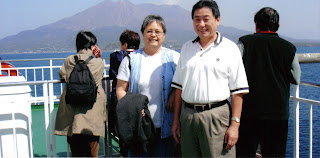Japan Travel Info - How to get there
How to Get There:
Kumamoto, with a population of approximately 1.5 million, is one of the larger cities on the southern island of Kyushu. In Japan history Kumamoto, known then as Higo, was ruled by daimyo lord Kato Kiyomasa, who built Kumamoto castle. Today a Shinkansen track and station is being built, and Kumamoto will be linked to Hakata and Kagoshima in Kyushu. Kumamoto is accessible from Tokyo by airplane, by train, and by bus. But recommended transportation mode is either by airplane from Tokyo airport Haneda, or by railways Japan JR train because of time and distance. Because of the sheer distance between Tokyo and Kumamoto city, I prefer a ride on the Japan Railways Shinkansen bullet train so that you can enjoy the wonderful scenery along the way if you have the time with an overnight stay in Kyoto. A trip on the JR Tokaido Kodama Shinkansen from Shinagawa station in Tokyo to Kyoto, as an example, would take about 4 hours, and by using the 7-day Japan Rail Pass(about $413 currently for a Green reserved car) would save you quite a sum. Use of the Japan Rail Pass over long runs really increases your savings over regular fares. Kyoto to Hakata presently takes just under 3 hours, and with a transfer to a LEX train Tsubame, you would be in Kumamoto city in 1 1/4 hours. Lacking time, a direct flight to Kumamoto by airplane on Japan Air Lines or All Nippon Airways will take just about 2 hours.
Japan Travel Info - Where to Stay
There are many hotels and inns to stay at in Kumamoto, however I recommend staying at hotels or ryokan near Kumamoto station which makes it easy for you to access the rail system and bus system for getting around. I personally like to stay at the Kumamoto Hotel Castle, which is located about 2 minutes from the famous Kumamoto Castle. The black walled castle, like the one Matsumoto, is one of a number of Japan tourist attractions. Japan Travel Info - Where to stay recommended.
Japan Travel Info - Things to do:
Japan Travel Info - Things to do recommendation: Kumamoto Castle - a very large and beautiful castle with black donjon(towers) built in the 1600s, destroyed by fire in 1877 during the Satsuma Rebellion, and reconstructed by the Kumamoto city in 1960.
Kumamoto Shopping - Visit Kumamoto city’s covered shopping arcades - Shimotori Arcade and Kamitori Arcade, along with Sun Road Shinshigai Arcade. The arcades are covered to protect you from the weather, and have a myriad of shops - clothing to 100 Yen shops, restaurants, knives, etc. in addition to large retailers such as Daiei.
Kumamoto Food - When in Kumamoto try Aoyagi Restaurant, near Shimotori Arcade, close to Daiei. Aoyagi is well-known and gets quite busy. My wife and I were allowed to use the tatami room(private room) and proceeded to have local specialty basashi(raw horse meat)which was very good, also mustard stuffed renkon(lotus root), sushi, and raw horse liver, which actually was quite good. The drinks were quite good too - sake from Niigata, and the local rice shochu(Shiro).
Japan Travel Info - Hitoyoshi Craft Park - area just outside Kumamoto city where you can interact and experience arts and crafts of Hitoyoshi-Kumamoto district. Drink tea and sample sweets in valuable pottery pieces. You can experience making various objects using potter’s wheel(rokuro), painting, and making small boxes (hanatebako). There are displays of various blacksmith-made kitchen knives, sickles, and hoes, which you can purchase. I personally bought a sashimi knife which I use today. Visit a shochu(distilled spirits similar to vodka)museum where the process of making shochu is demonstrated.
Hitoyoshi Spa - Hot spring inns(onsen ryokan)are located next to the Kumagawa. Be sure to stay in one and experience the healing waters of the onsen.
Shooting the Kumagawa rapids. Take a river ride on a boat going down the rapids. it’s a good photo taking opportunity as you go down river.
Aso-Kuju National Park - Nakadake Crater - an active volcano with smoke emanating from the crater. Stay at Uchinomaki Spa with its traditional onsen ryokans and Akamizu Spa with its onsen resort hotels.
Jibiki Ami - A Japanese "hukilau" netting fish. I was involved in hauling in a netful of assorted salt water fish. First the nets were laid out in the water, then the villagers went out in a small boat and hit the water with paddles to drive the fish into the nets. Then the people on the shore pulled in the nets with the fish. A fun activity!
Jibiki Ami - seashore off Kumamoto, Japan




















